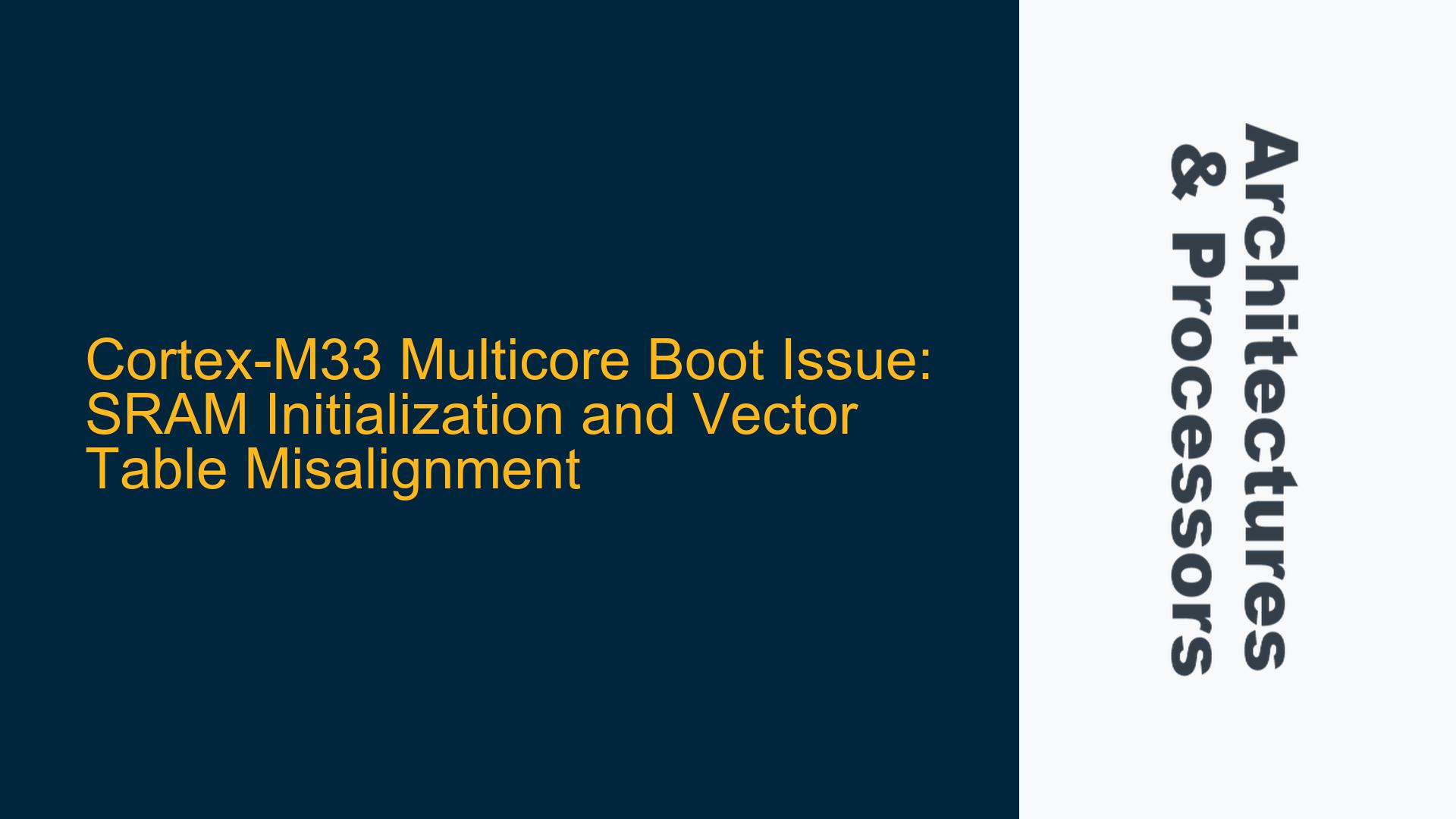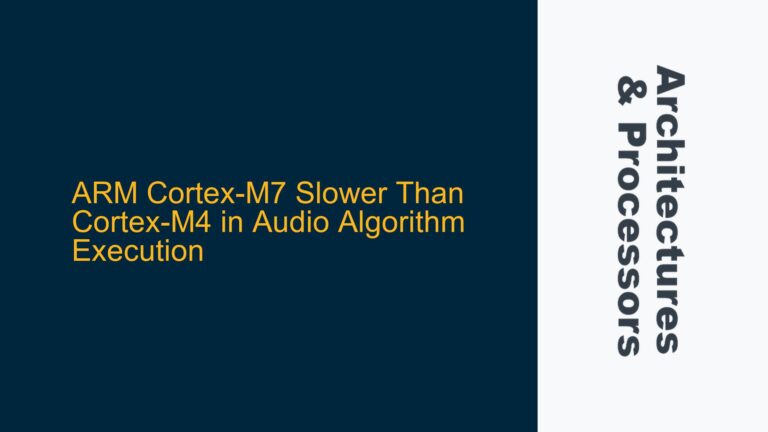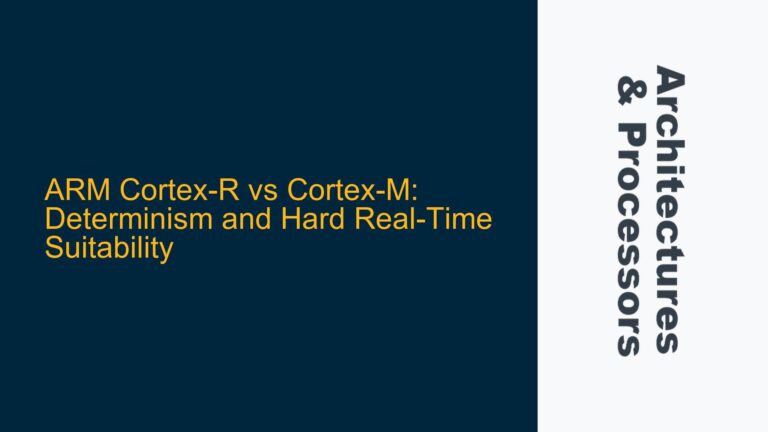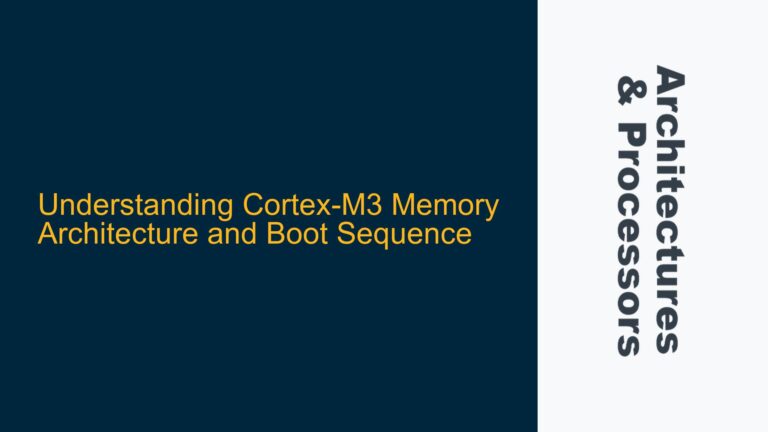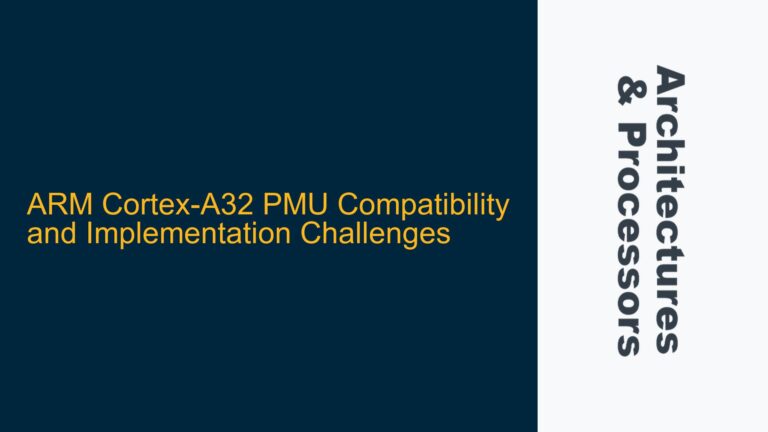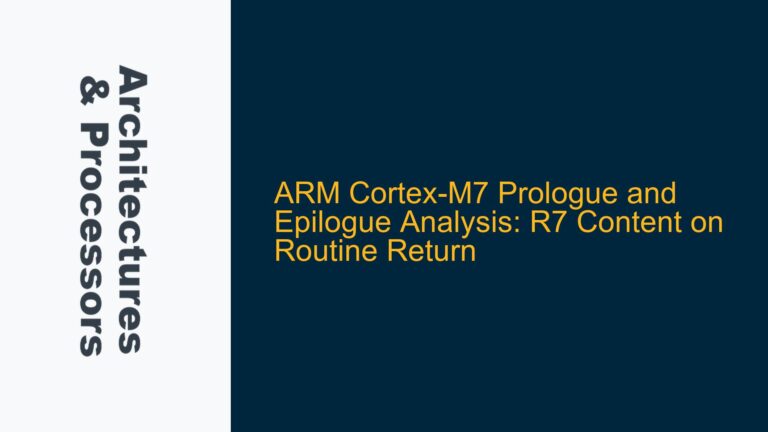Cortex-M33 Multicore Boot Failure Due to SRAM Code Loading
The Cortex-M33 processor, a member of the ARMv8-M architecture, is designed for embedded systems requiring high performance and security. One of its key features is support for multicore operation, which allows for parallel processing and improved system throughput. However, multicore systems introduce complexities, particularly during the boot process, where proper initialization and synchronization between cores are critical. A common issue arises when attempting to boot multiple cores using code loaded into SRAM instead of Flash memory. This issue manifests as one core failing to boot or incorrectly executing code intended for the other core, despite proper configuration of the initialization vector table register (INITVTOR1).
The root cause of this behavior lies in the timing and synchronization of memory accesses during the boot process. When code is loaded directly into SRAM, the memory controller and bus arbitration mechanisms may not guarantee that the second core accesses the correct memory location at the right time. This is especially problematic in multicore systems where both cores attempt to access shared resources simultaneously. Additionally, the Cortex-M33’s memory protection unit (MPU) and cache configurations can further complicate the boot process if not properly initialized.
To address this issue, a recommended approach is to load all code into Flash memory initially and then copy the necessary text segments to SRAM during runtime. This ensures that the memory controller and bus arbitration mechanisms are properly synchronized, and each core accesses the correct memory locations. The following sections delve into the possible causes of this issue and provide detailed troubleshooting steps and solutions.
Memory Controller Timing and Bus Arbitration Conflicts
One of the primary causes of the Cortex-M33 multicore boot issue is the timing of memory controller operations and bus arbitration conflicts. When code is loaded directly into SRAM, the memory controller must ensure that the correct memory locations are accessible to each core at the right time. However, in multicore systems, the memory controller may not always prioritize the boot sequence of the second core, leading to incorrect memory accesses or failed boot attempts.
The Cortex-M33’s bus matrix and arbitration mechanisms are designed to handle multiple simultaneous memory requests, but they rely on proper initialization and configuration. If the memory controller is not configured correctly, or if the bus arbitration logic is not synchronized with the boot sequence, the second core may access incorrect memory locations or fail to boot altogether. This is particularly problematic when using SRAM, as the memory controller must ensure that the correct memory regions are mapped and accessible to each core.
Another factor contributing to this issue is the timing of memory accesses during the boot process. When code is loaded directly into SRAM, the memory controller must ensure that the correct memory locations are accessible to each core at the right time. However, in multicore systems, the memory controller may not always prioritize the boot sequence of the second core, leading to incorrect memory accesses or failed boot attempts. This is especially problematic when using SRAM, as the memory controller must ensure that the correct memory regions are mapped and accessible to each core.
To mitigate these issues, it is essential to properly configure the memory controller and bus arbitration mechanisms. This includes setting the correct memory regions for each core, ensuring that the memory controller is properly initialized, and synchronizing the boot sequence with the bus arbitration logic. Additionally, it is recommended to load all code into Flash memory initially and then copy the necessary text segments to SRAM during runtime. This ensures that the memory controller and bus arbitration mechanisms are properly synchronized, and each core accesses the correct memory locations.
Improper Initialization of the Vector Table and MPU Configuration
Another significant cause of the Cortex-M33 multicore boot issue is improper initialization of the vector table and memory protection unit (MPU) configuration. The vector table is a critical component of the boot process, as it contains the initial stack pointer and reset handler addresses for each core. If the vector table is not properly initialized, the second core may fail to boot or execute incorrect code.
The Cortex-M33’s MPU is designed to provide memory protection and access control, but it must be properly configured to ensure that each core has access to the correct memory regions. If the MPU is not properly initialized, the second core may be denied access to critical memory regions, leading to a failed boot attempt. Additionally, the MPU configuration must be synchronized with the boot sequence to ensure that each core has access to the correct memory regions at the right time.
To address these issues, it is essential to properly initialize the vector table and MPU configuration. This includes setting the correct vector table addresses for each core, ensuring that the MPU is properly configured, and synchronizing the boot sequence with the MPU configuration. Additionally, it is recommended to load all code into Flash memory initially and then copy the necessary text segments to SRAM during runtime. This ensures that the vector table and MPU configuration are properly synchronized, and each core accesses the correct memory locations.
Implementing Flash-to-SRAM Code Copy and Synchronization Mechanisms
To resolve the Cortex-M33 multicore boot issue, a recommended approach is to implement a Flash-to-SRAM code copy and synchronization mechanism. This involves loading all code into Flash memory initially and then copying the necessary text segments to SRAM during runtime. This ensures that the memory controller and bus arbitration mechanisms are properly synchronized, and each core accesses the correct memory locations.
The first step in implementing this approach is to modify the linker script to ensure that the code segments are properly aligned and mapped to the correct memory regions. This includes setting the correct memory regions for each core, ensuring that the memory controller is properly initialized, and synchronizing the boot sequence with the bus arbitration logic. Additionally, it is essential to properly initialize the vector table and MPU configuration to ensure that each core has access to the correct memory regions.
Once the linker script is properly configured, the next step is to implement the code copy mechanism. This involves writing a bootloader that copies the necessary text segments from Flash memory to SRAM during runtime. The bootloader must ensure that the memory controller and bus arbitration mechanisms are properly synchronized, and each core accesses the correct memory locations. Additionally, the bootloader must properly initialize the vector table and MPU configuration to ensure that each core has access to the correct memory regions.
Finally, it is essential to implement synchronization mechanisms to ensure that each core boots correctly. This includes setting the correct vector table addresses for each core, ensuring that the MPU is properly configured, and synchronizing the boot sequence with the MPU configuration. Additionally, it is recommended to use hardware semaphores or other synchronization mechanisms to ensure that each core boots in the correct sequence.
By implementing these steps, the Cortex-M33 multicore boot issue can be effectively resolved, ensuring that each core boots correctly and accesses the correct memory locations. This approach not only addresses the immediate issue but also provides a robust framework for future multicore implementations.
Detailed Troubleshooting Steps and Solutions
To further assist in resolving the Cortex-M33 multicore boot issue, the following detailed troubleshooting steps and solutions are provided:
-
Linker Script Configuration: Ensure that the linker script is properly configured to map the code segments to the correct memory regions. This includes setting the correct memory regions for each core, ensuring that the memory controller is properly initialized, and synchronizing the boot sequence with the bus arbitration logic. The linker script should also define the correct vector table addresses for each core.
-
Bootloader Implementation: Implement a bootloader that copies the necessary text segments from Flash memory to SRAM during runtime. The bootloader must ensure that the memory controller and bus arbitration mechanisms are properly synchronized, and each core accesses the correct memory locations. Additionally, the bootloader must properly initialize the vector table and MPU configuration to ensure that each core has access to the correct memory regions.
-
Vector Table Initialization: Properly initialize the vector table to ensure that each core has the correct initial stack pointer and reset handler addresses. This includes setting the correct vector table addresses for each core and ensuring that the vector table is properly aligned in memory.
-
MPU Configuration: Properly configure the MPU to ensure that each core has access to the correct memory regions. This includes setting the correct memory regions for each core, ensuring that the MPU is properly initialized, and synchronizing the boot sequence with the MPU configuration.
-
Synchronization Mechanisms: Implement synchronization mechanisms to ensure that each core boots correctly. This includes using hardware semaphores or other synchronization mechanisms to ensure that each core boots in the correct sequence. Additionally, it is recommended to use memory barriers to ensure that the memory controller and bus arbitration mechanisms are properly synchronized.
-
Debugging and Verification: Use debugging tools to verify that each core boots correctly and accesses the correct memory locations. This includes using JTAG or other debugging interfaces to monitor the boot sequence and verify that the memory controller and bus arbitration mechanisms are properly synchronized. Additionally, it is recommended to use memory dump tools to verify that the code segments are properly copied to SRAM.
By following these detailed troubleshooting steps and solutions, the Cortex-M33 multicore boot issue can be effectively resolved, ensuring that each core boots correctly and accesses the correct memory locations. This approach not only addresses the immediate issue but also provides a robust framework for future multicore implementations.
Conclusion
The Cortex-M33 multicore boot issue is a complex problem that requires a thorough understanding of the memory controller, bus arbitration, vector table initialization, and MPU configuration. By implementing a Flash-to-SRAM code copy and synchronization mechanism, and following the detailed troubleshooting steps and solutions provided, the issue can be effectively resolved. This approach ensures that each core boots correctly and accesses the correct memory locations, providing a robust framework for future multicore implementations.
